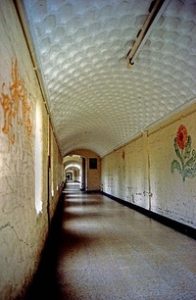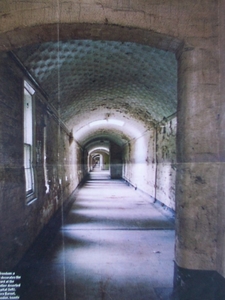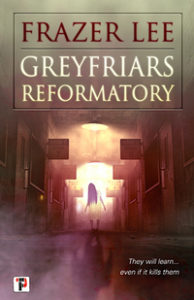Halloween Haunts: “You don’t have to be mad to work here, but it helps”
by Frazer Lee
In another life, and another time (1998 to be specific) I was hired to work crew for several weeks on a film shoot. The movie production in question was Siamese Cop, which had the awesome logline: ‘Two cops. One jacket’. A low-budget affair (no kidding) the bulk of the shoot was confined to one main location, which would also serve as the production base, equipment store, and – as it turned out – a place to haunt your every waking step.
Friern Barnet Mental Hospital, as it was then known, opened its doors as Colney Hatch Asylum in July 1851. Infamous inmates included 26-year-old Jack the Ripper suspect Aaron Kosminski (who was committed for mania and spent three years there before being carted off to Leavesden) and Maria Teresa Ferrari de Miramar, (Aleister Crowley’s second wife, who had delusions of grandeur that she was the daughter of the King and Queen along with addictions to drink and drugs that cursed other ‘Scarlet Women’ who consorted with Crowley). The hospital was renamed Colney Hatch Metal Hospital in the 1930s and at that time housed close to 3000 patients. The building took on the moniker of Friern Barnet Mental Hospital in 1959 (Friern Hospital for short) and remained so until its closure in 1993. By then it had fallen into a state of disrepair and dereliction in some areas.
When our film crew rocked up, no one had set foot inside the building, save the occasional security guard or property developer, for five long years.
The building’s most striking feature was its main corridor. This ran the entire length of the building and was  renowned as being the longest in Europe. I can testify to its length, as I had to lug filming equipment up and down the corridor for hours on end while we were shooting. (I was a lot slimmer back in 1998, let me tell you, and even more so after Siamese Cop). It was a fun shoot despite the rather basic conditions, and the crew became a tight-knit family, as they often do. But, when the long nights drew in, the atmosphere changed. Several crewmembers spoke about how they felt uneasy being inside the building at night.
renowned as being the longest in Europe. I can testify to its length, as I had to lug filming equipment up and down the corridor for hours on end while we were shooting. (I was a lot slimmer back in 1998, let me tell you, and even more so after Siamese Cop). It was a fun shoot despite the rather basic conditions, and the crew became a tight-knit family, as they often do. But, when the long nights drew in, the atmosphere changed. Several crewmembers spoke about how they felt uneasy being inside the building at night.
A few of us inquisitive enough, or stupid enough (or both!) to do so, got together during a break and sneaked downstairs to the basement level to take a look around. Access to the basement was forbidden – with rumours of asbestos to put us off snooping. But snoop we did, and we found depressing, dank corridors and dingy little isolation rooms down there complete with rusted beds and disturbing scratches – and other strange marks – on the walls. We were all a little quiet over dinner that evening, and I felt like we had absorbed some of the negative energy left behind by the poor souls confined to the basement during the building’s history. Popping outside for some much needed fresh Friern Barnet air, I found myself in the looming shadow of the building’s clock tower at the rear – and felt chilled to the bone.
 The spookiest time was at wrap each evening when we finished the day’s filming. I had been tasked with switching off the last of the lights (there was little mains power to the building so we had to run everything else from our own generator). When the instruction came to, “Kill the lights!” over my walkie-talkie, I knew what lay in store for me. First, the long walk to the lights at the far end of the building, where the green room was located. Then, the terrifying jog back along the now seemingly endless corridor (the longest in Europe, if you recall) with only my flashlight to guide me. I’ll be honest, I was more than a little petrified to think of being locked up in there overnight, and I pitied the poor souls who had been incarcerated there. I told myself that it was the cold making my hands shake as I locked the padlock each night.
The spookiest time was at wrap each evening when we finished the day’s filming. I had been tasked with switching off the last of the lights (there was little mains power to the building so we had to run everything else from our own generator). When the instruction came to, “Kill the lights!” over my walkie-talkie, I knew what lay in store for me. First, the long walk to the lights at the far end of the building, where the green room was located. Then, the terrifying jog back along the now seemingly endless corridor (the longest in Europe, if you recall) with only my flashlight to guide me. I’ll be honest, I was more than a little petrified to think of being locked up in there overnight, and I pitied the poor souls who had been incarcerated there. I told myself that it was the cold making my hands shake as I locked the padlock each night.
I popped back, once, to satisfy my curiosity about the grim old building. Would it be as spooky as I remembered it? I discovered that it was being converted into ‘classic luxury apartments, set in mature parkland’ as the sales blurb put it. The longest corridor in Europe was being chopped up and walled off to create entrances for the new residences. It gave me a chill to know that somewhere beneath them those strange marks remained carved into the walls, unseen but ever-present. The hospital changed its name to Princess Park Manor and I recall reading an article about pop stars such as One Direction buying apartments there. I still wonder how those new inmates are sleeping after lights out.
These experiences stayed with me, lurking in my subconscious, until they found their way back to the front of my mind when I wrote my sixth novel Greyfriars Reformatory. I didn’t realise until I began editing the book that the spooky clock tower, forbidden basement, and draughty corridors of my novel had their roots in the autumnal shadows of long ago. In many ways, I am still an inmate of that place, doomed to wander its corridors in my darkest dreams. 
 Frazer Lee is a novelist, screenwriter, and filmmaker. His first novel The Lamplighters was a Bram Stoker Finalist. He was awarded the Edgar Allan Poe Gothic Filmmaker Award for his folk horror movie The Stay. His sixth novel Greyfriars Reformatory is published October 2020 by Flame Tree Press/Simon and Schuster. Frazer lives with his family in Buckinghamshire, England – just across the cemetery from the actual Hammer House of Horror. Visit FrazerLee.com for more information.
Frazer Lee is a novelist, screenwriter, and filmmaker. His first novel The Lamplighters was a Bram Stoker Finalist. He was awarded the Edgar Allan Poe Gothic Filmmaker Award for his folk horror movie The Stay. His sixth novel Greyfriars Reformatory is published October 2020 by Flame Tree Press/Simon and Schuster. Frazer lives with his family in Buckinghamshire, England – just across the cemetery from the actual Hammer House of Horror. Visit FrazerLee.com for more information.




I loved this descriptive story!
Wow this is the best scariest story I ever read. You are so descriptive in your writing.